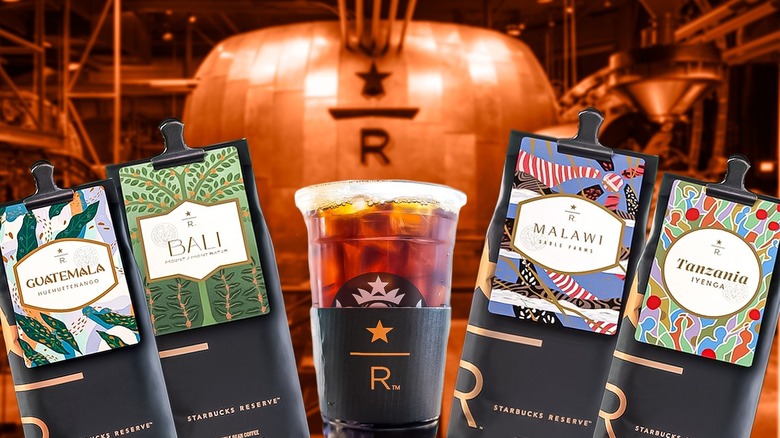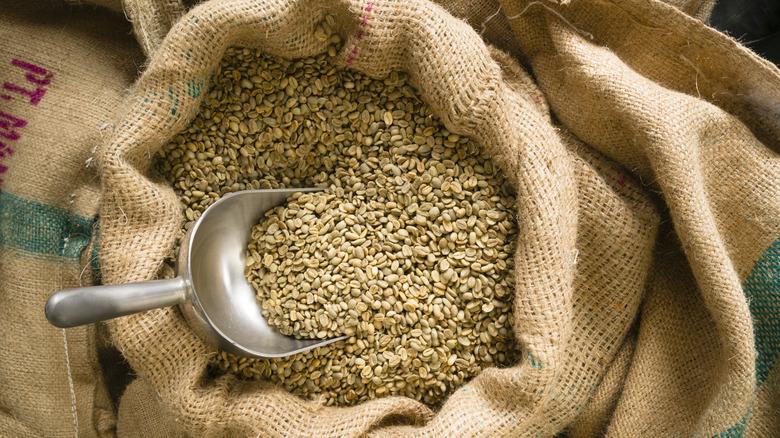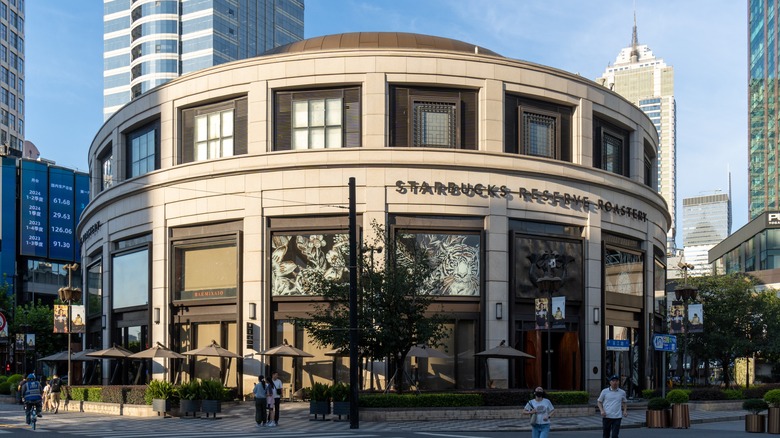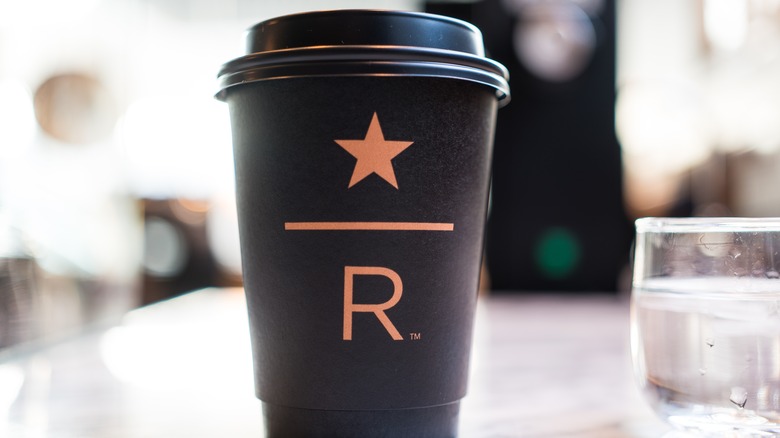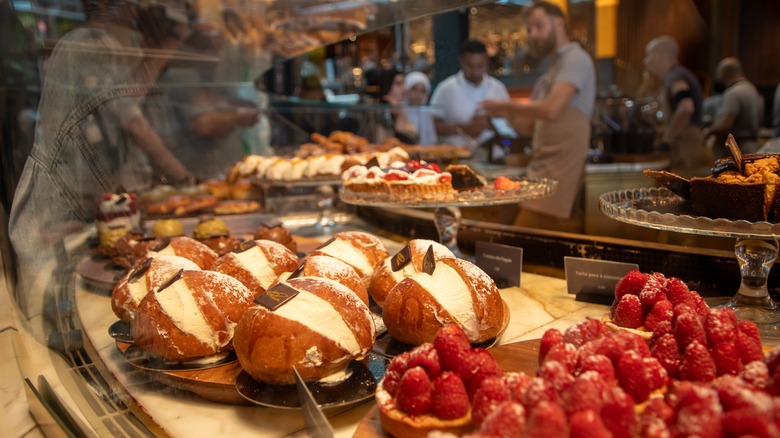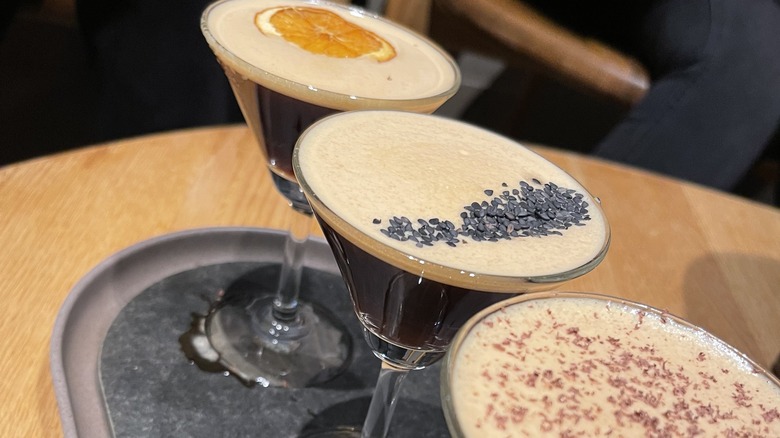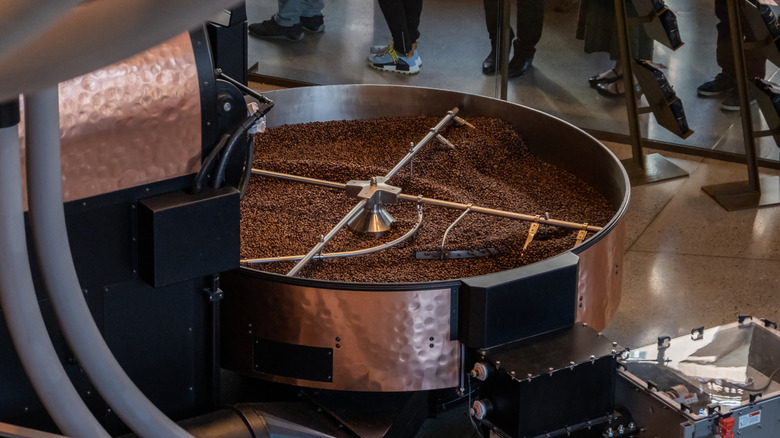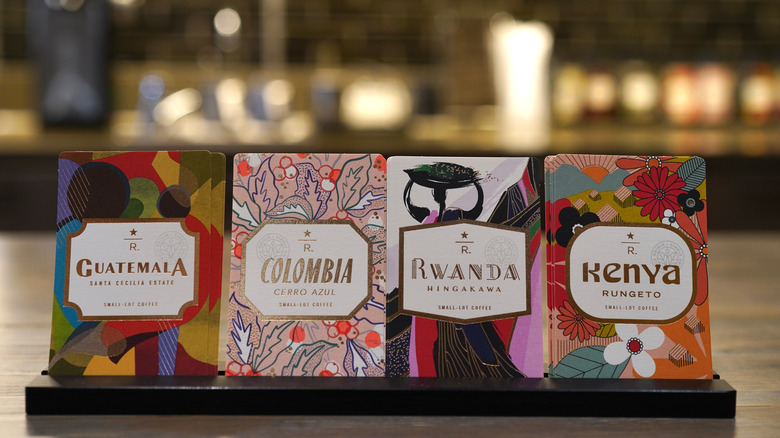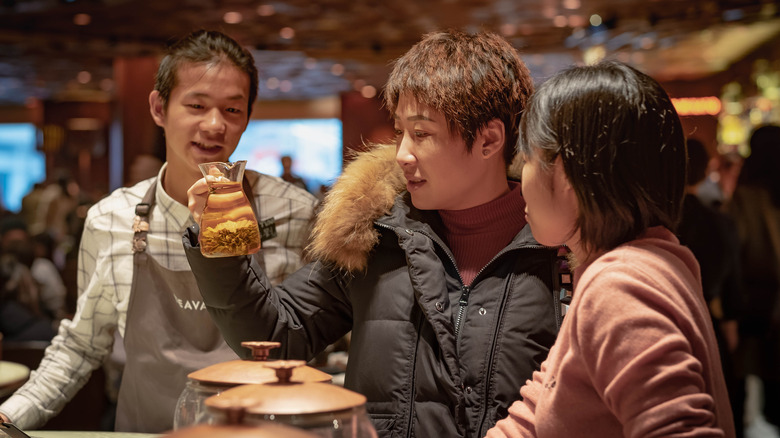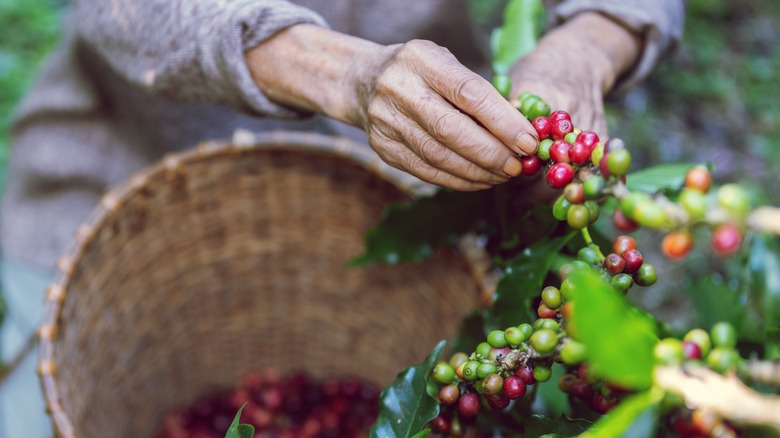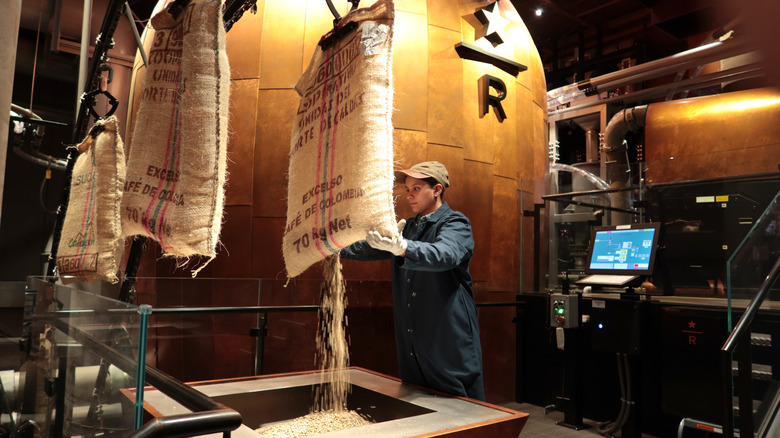10 Things Coffee Enthusiasts Should Know About Starbucks Reserve
Once Starbucks mastered the art of getting a caramel macchiato in the hands of seemingly every morning person in America, it took its craft to the next level with Starbucks Reserve — an upscale program that curates unique coffee-centered experiences and promotes an appreciation for the entire coffee process.
Hubs for the program are the Starbucks Reserve Roasteries — a concept far from the fast-food-style coffeehouses you might be used to. At each location, coffee enthusiasts are fueled with fresh varieties of brews that you can't get anywhere else. Each floor of these multilevel buildings is unique, yet they all come together to tell the story of the Reserve's dedication to sourcing, roasting, brewing, and experimenting with premium coffee.
There are also a few Starbucks Reserve Stores in the U.S., which are less immersive experiences than the roasteries but still sell the Starbucks Reserve coffee and Princi food. The Empire State Building Store in New York City, Greenwich Lane Store in New York City, and the SoDo Store in Seattle are the only Starbucks Reserve stores currently open. If you don't live by a Starbucks Reserve Roastery or Reserve Store, but you live in the U.S. or Canada, check your local Starbucks. It might be one of the select locations that sells Starbucks Reserve coffee on the shelves. Since so much detail and nuance has been put into the Starbucks Reserve program, we gathered some of the things you should know.
Beans are sourced from all over the world
Over 70 countries reside in the "Coffee Belt" — the region best suited for growing the trees responsible for coffee. With that being said, the most popular blends sold at regular Starbucks stores barely scrape the surface of what is possible.
At most Starbucks locations, the Pike Place Roast and Veranda Blend are brewed fresh every morning. These blends are made up of beans from Latin America — the region where the majority of Starbucks beans come from. Within the coffee belt, the three prime growing regions for coffee production are Latin America, Africa, and Asia/Pacific. If your taste buds are attuned to fine coffee, then you will notice how each region's coffee has its own unique flavor.
While many of Starbucks Reserve's beans still come from Latin America, the company has branched out to sourcing from other corners of the coffee belt as well. Through the Starbucks Reserve program, Starbucks Reserve Specialty Coffee Traders seek quality coffee beans from dedicated farmers around the world. For example, Sun-Dried Uganda Embogo comes from beans grown in the Rwenzori Mountains and Tanzania Iyenga is grown in the Songwe region of Tanzania.
When the Starbucks Reserve Specialty Coffee Traders find a farm or region to source from, they take the time to get to know the people in the growing community. This way, they can understand the story behind each batch of coffee and share it with customers.
There are only six Starbucks Reserve Roasteries worldwide
Having a Starbucks Reserve Roastery close to home is only a reality for residents of six cities throughout the world. The rest of us are stuck with regular Starbucks stores, which are generously scattered across the globe.
When the first Starbucks Reserve Roastery opened in Seattle in December 2014, it marked the beginning of the company's pursuit of elevating the coffeehouse experience throughout the world. Roasteries in New York, Chicago, Milan, Tokyo, and Shanghai soon followed — the newest and biggest being in Chicago's Magnificent Mile.
Starbucks Reserve Roasteries were not always intended to be exclusive to so few cities. Before the current CEO Kevin Johnson stepped in, Starbucks planned to expand the Starbucks Reserve program by opening 30 new Roasteries. However, Johnson told the Wall Street Journal in 2019 that the chain would likely stick to six to 10 Roasteries — over five years later and he has stuck to his word.
When you are visiting a Starbucks Reserve Roastery, you can almost guarantee that you will be surrounded by aromas of freshly roasted coffee and baked goods while in a setting plastered with art and unique design elements. All of the Reserve Roasteries have the same core elements, including various bars and enthusiastic employees who maintain the energy of the building. However, the Reserve Roasteries vary in size, design, and special additions. Some highlights include the Barrel-Aged Coffee Bar in Chicago, the AMU Inspiration Lounge in Tokyo, and the Coffee Library in Seattle.
Starbucks Reserve Roasteries serve exclusive menu items
Those who frequent their local Starbucks might be in the habit of forgoing the menu and ordering their regular — whether that be a Java Chip Frappuccino or Pike Place Roast drip coffee. However, if you don't pause to browse the menu at a Starbucks Reserve Roastery, you might miss out on its exclusive drinks.
The Starbucks Reserve Roastery has a section in the menu titled "coffee creations" where you can find drinks such as the Toffeenut Bianco Latte and Dark Chocolate Mocha. While they are reminiscent of some of the drinks you might be familiar with, you will likely be looked at funny if you try to order these at your local Starbucks, since these creations are made with coffee and ingredients exclusive to Starbucks Reserve Roasteries. The Roastery is the first place Starbucks debuts new coffee endeavors, such as its Whiskey Barrel-Aged drinks. These drinks are aged in Whiskey barrels so that the beans eventually take on some of its flavor. While they are meant to taste like Whiskey, you won't get a buzz since they are not actually alcoholic. Starbucks Reserve debuted these drinks in 2017 and has since featured creations such as the Pumpkin Spice Whiskey Barrel-Aged Cold Brew, Whiskey Barrel-Aged Cold Brew, and Whiskey Barrel-Aged Malt.
Not all Reserve Roasteries have the same menu, either. For example, Chicago does not have the affogatos and malts selection that Seattle and other locations have, but it does have a Strawberry Balsamic Spritz available.
Princi baked goods are made in-house
When you order a breakfast sandwich or pastry from the case at a regular Starbucks store, baristas reach for it in the fridge behind the counter and heat it up. While reliable for a weekday breakfast, it lacks fresh ingredients and true in-house preparation. Luckily, you are not expected to pair your artfully crafted espresso drink with a frozen sandwich at a Starbucks Reserve Roastery.
Princi is responsible for all of the food served at Starbucks Reserve Roasteries throughout the world. This bakery had been around long before it partnered with Starbucks Reserve in 2016. Founder Rocco Princi began his reputation for baking fresh artisan bread and baked goods in 1986 when he opened his first bakery in Milan. Now, his food can be found throughout the world in Starbucks Reserve Roasteries and stand-alone stores.
At Princi, ingredients straight from Italy are transformed in-house into a variety of sweet and savory treats. As with most elements of the Reserve Roasteries, the exact menu items vary from location to location.
Fans of Starbucks' Bacon, Gouda & Egg sandwich might fancy an upgrade to Princi's Porchetta & Egg On Ciabatta. Or, if you prefer Tomato & Mozzarella on Focaccia, Princi's Caprese on Focaccia might exceed your cravings. Some menu items, however, are not comparable to Starbucks' regular menu, such as Princi's Eggs in Purgatory or olive oil cake. In general, food is going to cost more at the Reserve Roastery, but the quality makes up for it.
You can order alcohol at the Reserve Roasteries
Before the Reserve Roasteries opened, the only type of buzz Starbucks beverages was known to give were fueled by caffeine. Now, when someone asks what your favorite Starbucks drink is, you can say espresso martini.
If it weren't sandwiched in between coffee bars in a building dedicated to the appreciation of coffee, the Arriviamo Bar could pass as any upscale city bar. However, its menu, filled with beverages that are both caffeinated and alcoholic, makes its Starbucks affiliation very clear. If you, for some reason, visited the Reserve Roastery and don't love coffee, you can order traditional alcoholic beverages at the Arriviamo Bar as well.
While Starbucks Reserve is a trendsetter in its coffee creations, that doesn't necessarily mean it's set to excel in cocktail culture. However, the company seems to exert a steady flow of creative energy into its mixology endeavor. Ever since espresso martinis have been trending, it seems obvious for a Starbucks bar to have it on the menu. Which of course it does, but Starbucks Reserve also innovates the trending drink by adding flavored liquors and serving them in flights. For a seasonal twist of the classic, it also has a Starbucks Reserve Pumpkin Spice Espresso Martini.
If you want a flight but aren't a fan of espresso martinis, there is also the Whiskey Barrel-Aged Cold Brew Comparison Flight, where you can taste spirit-Free Starbucks Reserve Whiskey Barrel-Aged Cold Brew and compare it to Knob Creek Kentucky Straight Bourbon Whiskey. Or you can try one of the specialty tea-based drinks, such as Sparkling Sakura Allure.
The roasting process is on display
At many coffee bars, you can order a cappuccino and then watch as the baristas craft your drink out of coffee grounds. Watching coffee be steeped into a shot glass and poured into a cup with frothed milk is nothing new, but it's not every day you get to see the steps that happen before the beans get behind the bar.
Starbucks Reserve Roastery takes the mystery out of the coffee roasting process by putting it right in front of coffee enthusiasts to watch how their favorite drink is made. While you enjoy your coffee, cocktail, baked goods (or all of the above), you can see fresh coffee being roasted by Starbucks Reserve master roasters.
Each Starbucks Reserve Roastery's setup is a little different, but they all contain roasters and storage equipment for the beans. Guests can watch as master roasters carefully roast the coffee that will eventually end up in Starbucks Reserve cups and bags.
If you are wondering why a master did something a certain way, you can just ask them. Questions are welcome at the Reserve Roastery. But, if you are simply wondering what the location is roasting that day — no need to ask. Just look up to the "clacker board" — or "Solari Board," depending on the location, which has information on the daily roast.
Art and design fill the Reserve Roasteries
Starbucks Reserve intersects beauty with function in every Roastery. From the giant casks of roasted coffee beans to the custom Starbucks Reserve coffee cards, art is everywhere.
In order to store the freshly roasted beans to degas before being distributed, every roastery needs a cask. Instead of opting for a commercially made piece of equipment, each cask doubles as a piece of art with a different design at each location. For example, the cask at the Chicago roastery extends 56 feet in the air with a perforated exterior, varying greatly from Milan's 22-foot rotating cask.
Starbucks Reserve also uses art to label and market its beans. With each bag of coffee comes a custom coffee card inspired by the bean's origins. Those familiar with these regions might be able to spot certain symbolism of the culture integrated into the design. But the creativity doesn't stop there. Some of the locations have taken these cards and used them to create a mural-like piece of art on one of the walls at the Roastery.
As far as the design of the Roastery itself goes, each one has unique artistic elements added to the space. To name a few, the New York Reserve Roastery worked with a New York artist to make the Siren Sculpture in the main bar, the Tokyo location has an Origami Ceiling on the second floor, and the Chicago location has a local artist's mural inspired by the coffee growing process which spanning four levels.
You can book a Signature Starbucks Reserve Experience
It's one thing to bring home a bag of coffee as a souvenir, but leaving a city with a new skill or wealth of knowledge is the best way to impress your friends at home — or annoy them, depending on your delivery. Walking into a Starbucks Reserve Roastery is free — and arguably an enriching experience in itself — but Signature Starbucks Reserve Experiences provide additional opportunities for those who want to dive deeper into coffee culture. Most of these are ticketed and require a fee, which varies depending on the experience.
These experiences range from private tours to tastings to classes. To give you an idea of the types of experiences available, "Coffee Lab: A Journey of the Senses" and "Art of the Espresso Martini" are among the current offerings. While they share some of the same experiences, not all of the roasteries have the same options available.
If you are a coffee enthusiast on a budget, you might get lucky and align with one of Starbucks Reserve's free experiences. In the past, it has offered free admission to "Starbucks Reserve Coffee Sampling," "Learn the Art of Chemex," and "'Meet the Artist ': Daryl Daniels, at the Starbucks Reserve Roastery NYC."
The company supports coffee growing communities
Without passionate farmers, Starbucks Reserve has no beans to roast and no cold brew to serve on hot summer days. The success of Starbucks Reserve relies on the hard work and dedication of the farmers in its growing communities. Not only does the Starbucks Reserve program seek out family-run farms for its beans, but the company is known to help out these communities in areas of need through financial support.
For example, Starbucks provided a grant for a community center to be built for the members of the Abakundakawa co-op in the Gakenke District of Rwanda. Before the construction of this large space, the area did not have a designated space for meetings, weddings, or other special events.
Similar support for its growing communities was shown in Malawi's Mangochi District. Starbucks supported the education of children in the growing community by providing clean water for students, boosting morale by renovating teacher's homes, and repairing some of the school's facilities.
Starbucks Reserve specializes in small-batch coffee
Instead of being processed at a manufacturing facility, coffee sold under the Starbucks Reserve name is made in small batches at one of the Starbucks Reserve Roasteries. Making small-batch coffee means smaller quantities are roasted at a time — a change in pace from the roasting process of the blends typically sold in regular Starbucks stores.
By opting for small-batch coffee roasting, control of the roast is not overwhelmed by the amount of beans being processed. Instead, Starbucks Reserve master roasters are able to more easily manipulate the roast to reflect their vision of what the result should taste like. Seemingly small changes in the roasting process can make a big difference in the final product.
Some of the Starbucks Reserve Roasteries have what the company calls a "small roaster" and a "large roaster." The small roaster is dedicated specifically to roasting the coffee served on the premises, ensuring these fresh beans are roasted with attention to detail. The big one is used for larger batches that are distributed throughout the world.
Most of the Starbucks Reserve coffee beans are single-origin, meaning all of the beans come from the same place and not a mixture of multiple sources. However, Starbucks Reserve does offer some microblends, such as the blend named after each location, sold only at the respective location. Other microblends include Microblend No. 21 Coffee and Microblend No. 10 Coffee.
